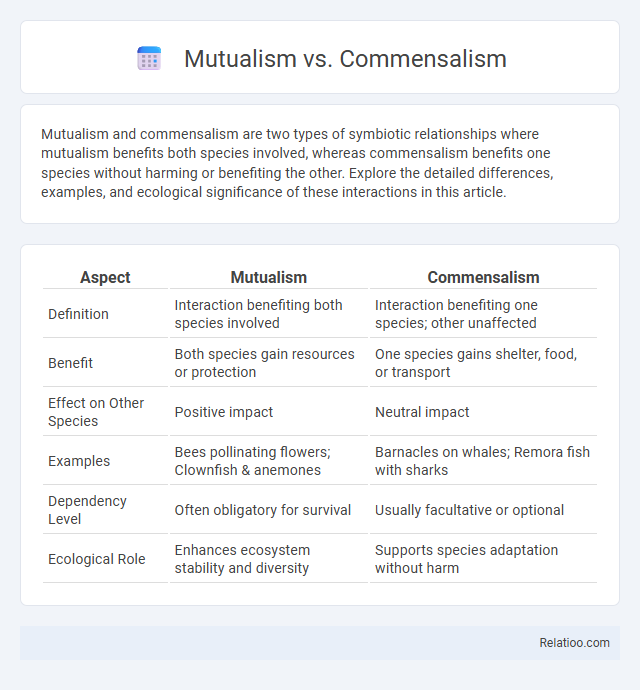Mutualism and commensalism are two types of symbiotic relationships where mutualism benefits both species involved, whereas commensalism benefits one species without harming or benefiting the other. Explore the detailed differences, examples, and ecological significance of these interactions in this article.
Table of Comparison
| Aspect | Mutualism | Commensalism |
|---|---|---|
| Definition | Interaction benefiting both species involved | Interaction benefiting one species; other unaffected |
| Benefit | Both species gain resources or protection | One species gains shelter, food, or transport |
| Effect on Other Species | Positive impact | Neutral impact |
| Examples | Bees pollinating flowers; Clownfish & anemones | Barnacles on whales; Remora fish with sharks |
| Dependency Level | Often obligatory for survival | Usually facultative or optional |
| Ecological Role | Enhances ecosystem stability and diversity | Supports species adaptation without harm |
Understanding Symbiotic Relationships
Symbiotic relationships involve close, long-term interactions between different species, where mutualism benefits both parties, commensalism benefits one without harming the other, and parasitism harms one while benefiting the other. Understanding these interactions highlights how ecosystems maintain balance and interdependence, with mutualism enhancing resource exchange and commensalism allowing coexistence without negative impact. Your knowledge of symbiotic relationships can deepen appreciation for biodiversity and inform conservation strategies.
Defining Mutualism: A Win-Win Scenario
Mutualism is a type of symbiotic relationship where both species involved directly benefit, creating a win-win scenario essential for ecosystem stability. Unlike commensalism, where one species benefits without affecting the other, mutualism fosters reciprocal advantages such as nutrient exchange, protection, or enhanced reproduction. This collaborative interaction enhances biodiversity and supports ecological balance by promoting interdependence among species.
Exploring Commensalism: One Benefits, One Unaffected
Commensalism is a type of symbiotic relationship where one organism benefits while the other remains unaffected, such as barnacles attaching to whales without harming them. This contrasts with mutualism, where both organisms gain advantages, and parasitism, which benefits one at the expense of the other. Understanding commensalism helps you appreciate the complex interactions within ecosystems that maintain biodiversity without negative impacts.
Key Differences Between Mutualism and Commensalism
Mutualism and commensalism are both types of symbiotic relationships but differ in the benefits provided to the organisms involved. In mutualism, both species gain essential benefits, such as nutrient exchange between nitrogen-fixing bacteria and leguminous plants, enhancing survival and growth. In commensalism, one organism benefits without affecting the other, like barnacles attachment on whales, where the barnacles gain mobility without harming the host, emphasizing your understanding of these ecological interactions.
Examples of Mutualism in Nature
Mutualism represents a biological interaction where both species benefit, such as bees pollinating flowers while collecting nectar, or clownfish gaining protection from anemones while providing cleaning services. Commensalism involves one species benefiting without affecting the other, like barnacles attaching to whales for transportation without harming the host. Symbiosis broadly encompasses mutualism, commensalism, and parasitism, describing any close or long-term biological interaction between two different species.
Examples of Commensalism in Ecosystems
Commensalism in ecosystems occurs when one species benefits while the other remains unaffected, such as barnacles attaching to whales, gaining transportation and access to food particles without harming the whale. Epiphytes like orchids growing on trees absorb moisture and nutrients from the air, benefiting without impacting the host tree's health. Another example includes cattle egrets feeding on insects stirred up by grazing herbivores, where the birds gain food and herbivores experience no significant effect.
Ecological Importance of Symbiotic Interactions
Symbiotic interactions, including mutualism and commensalism, play a crucial role in maintaining ecosystem stability and productivity by facilitating nutrient cycling, enhancing species survival, and promoting biodiversity. Mutualism benefits both species involved by providing essential resources or protection, while commensalism supports one species without harming the other, contributing to balanced community dynamics. Understanding these relationships can help you appreciate the intricate dependencies that sustain ecological networks and improve conservation strategies.
Mutualism and Commensalism in Human Life
Mutualism in human life exemplifies relationships where both parties benefit, such as gut microbiota aiding digestion while receiving nutrients. Commensalism occurs when one organism benefits without affecting the other, like certain skin bacteria thriving on humans without harm or benefit to them. Understanding these interactions highlights your body's complex ecosystem and its role in maintaining health.
Factors Influencing Symbiotic Relationships
Factors influencing symbiotic relationships include environmental conditions, resource availability, and species-specific adaptations that determine interaction balance. Mutualism thrives when both species benefit through nutrient exchange or protection, while commensalism exists where one species gains advantage without harming the other, often in stable habitats with niche differentiation. Symbiosis encompasses a spectrum of interactions shaped by evolutionary pressures and ecological contexts, influencing collaboration intensity and dependency levels among organisms.
Future Research and Conservation Implications
Future research on mutualism, commensalism, and symbiosis will likely emphasize the molecular mechanisms and gene expression profiles underpinning these interspecies interactions, enhancing our understanding of ecosystem resilience. Conservation strategies can benefit from integrating knowledge of these relationships to maintain biodiversity and ecosystem services, particularly in habitats vulnerable to climate change and anthropogenic disturbances. Employing advanced genomic tools and environmental DNA (eDNA) monitoring will improve detection and preservation of key species involved in these ecological interactions.

Infographic: Mutualism vs Commensalism
 relatioo.com
relatioo.com